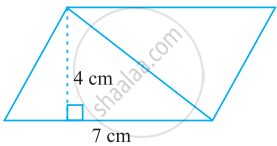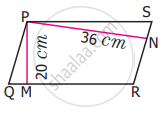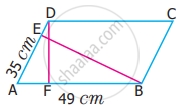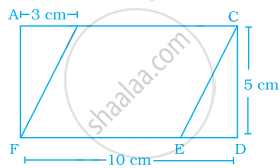Advertisements
Advertisements
प्रश्न
To find area, any side of a parallelogram can be chosen as ______ of the parallelogram.
उत्तर
To find area, any side of a parallelogram can be chosen as base of the parallelogram.
Explanation:
While calculating the area of the parallelogram, we can choose any side as base.
APPEARS IN
संबंधित प्रश्न
Find the area of the following parallelogram:

Find the area of the following parallelogram:

PQRS is a parallelogram (see the given figure). QM is the height from Q to SR and QN is the height from Q to PS. If SR = 12 cm and QM = 7.6 cm. Find:
- the area of the parallelogram PQRS
- QN, if PS = 8 cm

A parallelogram has sides of 15 cm and 12 cm; if the distance between the 15 cm sides is 6 cm; find the distance between 12 cm sides.
The adjacent sides of a parallelogram are 21 cm and 28 cm. If it's one diagonal is 35 cm; find the area of the parallelogram.
Find the missing values.
| Base | Height | Area |
| 18 cm | 5 cm |
Find the missing values.
| Base | Height | Area |
| 17 mm | 221 sq.mm |
In a parallelogram PQRS (See the diagram) PM and PN are the heights corresponding to the sides QR and RS respectively. If the area of the parallelogram is 900 sq.cm and the length of PM and PN are 20 cm and 36 cm respectively, find the length of the sides QR and SR
The area of the parallelogram ABCD is 1470 sq.cm. If AB = 49 cm and AD = 35 cm then, find the height, DF and BE
In the given figure, area of parallelogram BCEF is ________ cm2 where ACDF is a rectangle.

